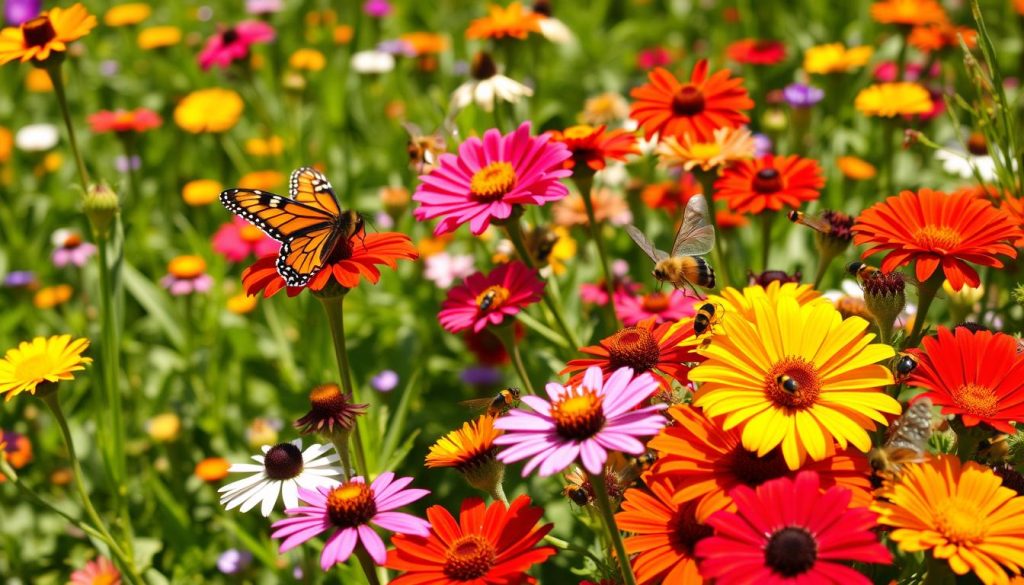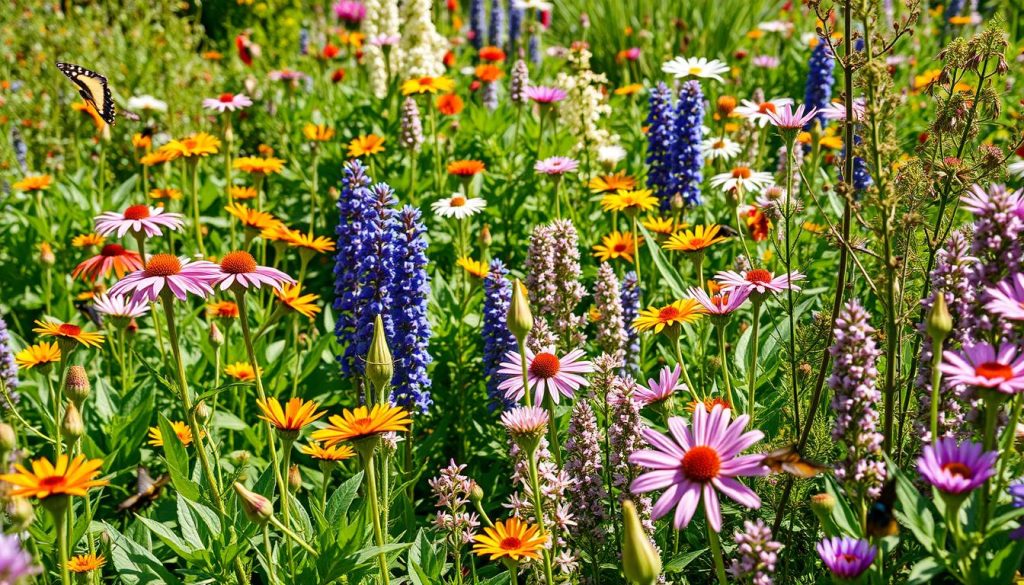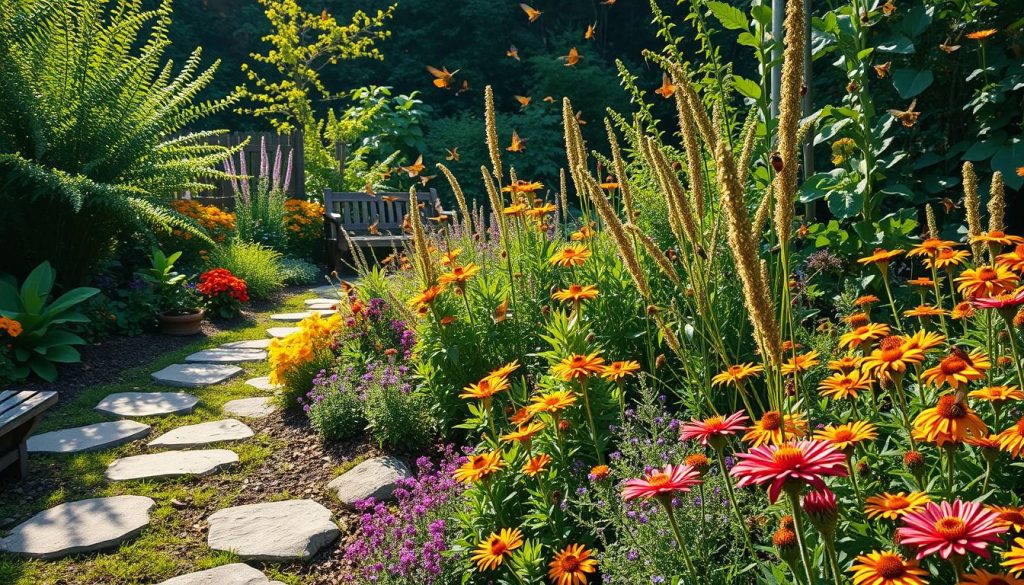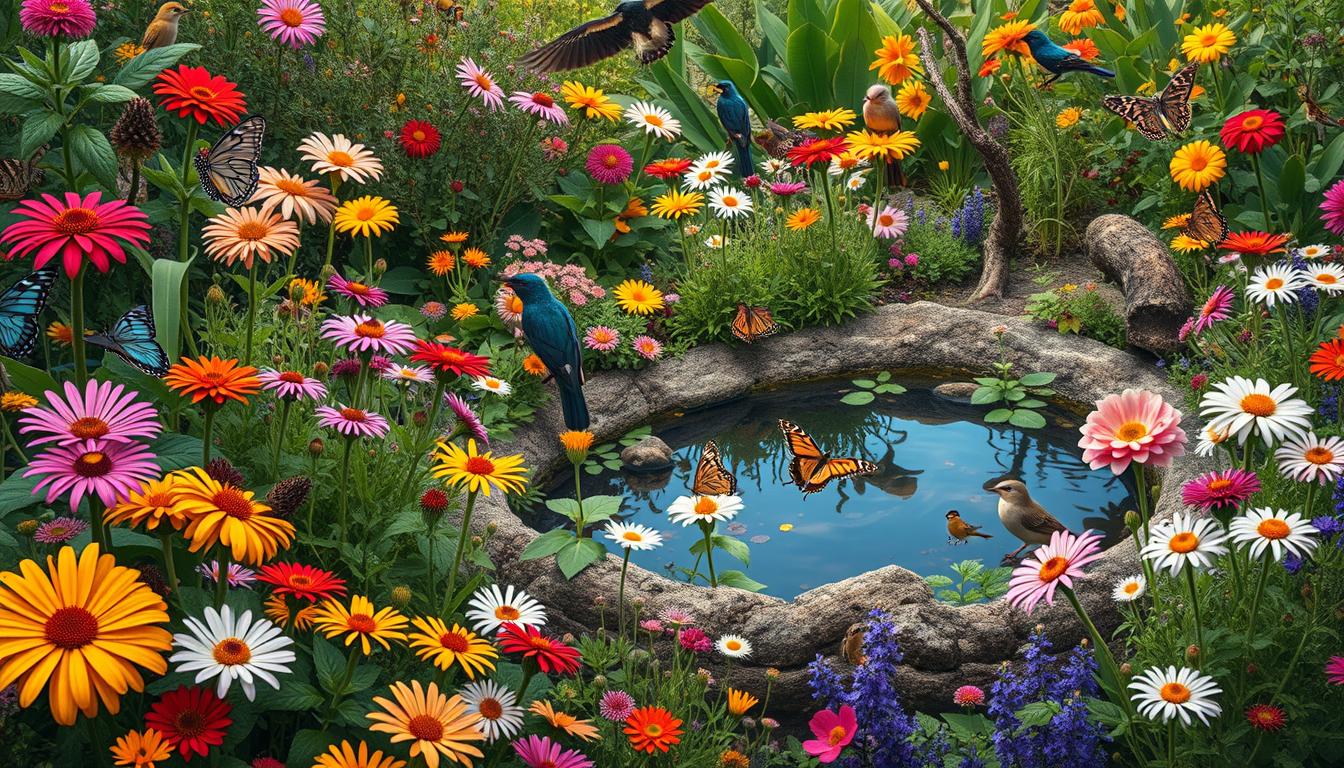Welcome to my guide on creating a thriving wildlife and pollinator garden. Here, I’ll share my knowledge on Wildlife and Pollinator Gardening. This includes the importance of native plants and habitat restoration.
In this article, we’ll look at the key elements of a beautiful and thriving garden. We’ll see how to choose the right location and pick native plants for your garden.
By following these tips and guidelines, you can make a stunning garden. It will not only help the environment but also give you a peaceful place to relax. All while promoting Wildlife and Pollinator Gardening and habitat restoration.
Understanding the Importance of Wildlife and Pollinator Gardens
Exploring wildlife and pollinator gardens shows us their vital role in saving biodiversity. These gardens help us restore habitats and garden sustainably. They support many species, including bees and butterflies, which are key to pollination.
What Are Wildlife and Pollinator Gardens?
Wildlife and pollinator gardens are made to attract local wildlife like pollinators, birds, and beneficial insects. They use native plants for food and shelter. These gardens help conserve biodiversity and improve ecosystem health.
Why They Matter for Biodiversity
Wildlife and pollinator gardens are crucial. They offer a safe space for species facing challenges in urban or damaged areas. By preserving habitats, we help ecosystems stay balanced and our planet healthy.
Benefits for Local Ecosystems
These gardens do more than just help specific species. They also boost local ecosystems’ health. They improve air and water quality and help fight climate change. Sustainable gardening and habitat restoration make our environment stronger and more vibrant.

Choosing the Right Location for My Garden
When setting up a wildlife and pollinator garden, picking the right spot is key. I must think about sunlight, soil quality, and how close it is to water. This will help my garden flourish with native plants, beneficial insects, and plants that help bees.
Assessing Sunlight and Shade
I’ll figure out how much sun and shade my garden will get. Most native plants need at least 6 hours of direct sunlight. Others do better in partial shade. I’ll also check the soil’s moisture-holding ability, as it affects what plants I can grow.
Evaluating Soil Quality
Soil quality is vital. I’ll test my soil to see its pH level and nutrient content. This helps me pick the best native plants for my garden. Bees and butterflies love gardens with a variety of plants that offer nectar and pollen.
Some key things to think about for my garden include:
- Planting a mix of native plants that provide nectar and pollen for beneficial insects
- Creating a diverse garden with a variety of plants that attract different types of wildlife
- Using natural methods to control pests and diseases, rather than relying on pesticides

Proximity to Water Sources
A reliable water source is crucial for a healthy garden. I’ll look at how close my garden is to a water source, like a pond or birdbath. This ensures my plants and wildlife have enough water. By choosing wisely, I can make a beautiful garden that attracts native plants, beneficial insects, and bee-friendly plants.
Selecting Native Plants for Attracting Pollinators
Creating a bird-friendly garden or a butterfly garden design starts with native plants. These plants have evolved with local wildlife. They offer food and shelter, making your garden a haven.
Best Native Flowers for Bees
Bees are key pollinators, and they love native flowers. Flowers like coneflowers, black-eyed susans, and lavender are great. They’re full of nectar and pollen, perfect for bees.
Trees and Shrubs That Support Wildlife
Trees and shrubs are vital for wildlife, including birds, butterflies, and bees. Native options like oak trees, willow shrubs, and dogwood trees are great. They offer berries, seeds, and leaves, essential for wildlife survival.

Creating Year-Round Blooming Cycles
Having plants that bloom all year is key for wildlife and pollinators. Plant a mix of native plants that bloom at different times. This way, your garden will always have something in bloom, supporting local wildlife all year.
Designing an Inviting Garden Layout
Creating a wildlife and pollinator garden needs a good layout to attract many species. A well-designed garden is a haven for butterflies, bees, and more. It also uses sustainable gardening practices. Native plants are key for a thriving ecosystem.
Layering Plants for Habitat Diversity
Using plants of different heights makes a garden diverse and welcoming. This includes native flowers, shrubs, and trees. They offer food, shelter, and breeding spots for pollinators. Native plants in my garden support the environment and local life.
Creating Natural Pathways
Natural paths use native plants, rocks, and more. They add beauty and help save water and reduce upkeep. Sustainable gardening, like mulching and composting, makes my garden beautiful and supports wildlife.

Incorporating Water Features
| Water Feature | Benefits |
|---|---|
| Pond | Provides habitat for aquatic species, attracts pollinators |
| Birdbath | Offers drinking water for birds and butterflies, creates visual interest |
| Rain Garden | Collects and filters rainwater, reduces stormwater runoff |
These design elements make my garden beautiful and sustainable. It supports local wildlife and pollinators. It also promotes eco-friendly practices like native plant gardening and water conservation.
Building Shelter and Nesting Areas
As I learn more about wildlife and pollinator gardening, I see how crucial shelter and nesting areas are. These spots are vital for local wildlife, including beneficial insects and birds. They help keep my garden healthy and support biodiversity.
I think about the types of shelters I can build, like brush piles, rock piles, or insect hotels. These places offer safety from predators, harsh weather, and other dangers. I also focus on meeting butterflies’ nesting needs, like providing flat stones for them to warm up. Plus, I consider installing birdhouses or bird feeders for birds.
Types of Wildlife Shelters
- Brush piles: Provide shelter and protection for small mammals and birds
- Rock piles: Offer basking sites for reptiles and amphibians
- Insect hotels: Support solitary bees and other beneficial insects
Important Nesting Needs for Butterflies
Butterflies need specific conditions to nest and lay their eggs. I ensure they have flat stones or rocks to land on and warm up. I also plant nectar-rich flowers for them to feed on. This way, my garden supports the life cycle of these beautiful creatures.
Supporting Beneficial Insects in My Garden
To make my garden a haven for wildlife and pollinators, I focus on supporting beneficial insects. These insects are key to keeping my garden’s ecosystem in balance. By gardening sustainably and using native plants, I attract helpful insects like ladybugs and lacewings. They help control pests naturally.
I create habitats for these beneficial insects by planting a variety of native plants. This provides them with food and shelter. For instance, I plant marigolds and cosmos to attract ladybugs. I also add native grasses and shrubs to offer shelter for lacewings. This approach helps restore habitats and welcomes beneficial insects into my garden.
Moreover, I steer clear of harmful pesticides to protect these beneficial insects. Instead, I use natural methods to manage pests. This includes introducing beneficial insects or using barriers to keep pests away. By doing this, I ensure my garden is a healthy, thriving space for both wildlife and pollinators.
Seasonal Maintenance and Care for My Garden
To keep my garden thriving, I focus on seasonal care. I use best practices for pruning and weeding. I also use smart watering methods to keep the garden lively all year.
By adding habitat restoration, I help local wildlife and pollinators. This attracts beneficial insects and grows bee-friendly plants.
Some key tasks include:
- Pruning plants to promote healthy growth and encourage blooming
- Weeding to prevent competition for nutrients and water
- Watering techniques that conserve water and reduce waste
By following these steps and adding habitat restoration, I create a haven. This supports beneficial insects and pollinators, helping the local ecosystem.
As I care for my garden, I stick to eco-friendly methods. These methods support habitat restoration and attract beneficial insects. This way, I enjoy a thriving garden that brings me joy and helps local wildlife and pollinators.
| Season | Maintenance Tasks |
|---|---|
| Spring | Pruning, weeding, and planting bee-friendly plants |
| Summer | Watering, mulching, and monitoring for pests |
| Autumn | Harvesting, composting, and preparing for winter |
| Winter | Protecting plants from frost, and planning for the upcoming season |
Engaging with My Community
As I grow my love for wildlife and pollinator gardening, I see how vital it is to share this passion. By connecting with my community, I can encourage others to start their own bird-friendly or butterfly garden. This helps protect our local wildlife.
Hosting Workshops and Events
I’ve begun hosting workshops in my neighborhood about pollinator gardens. I share my knowledge and tips for a successful garden. These gatherings help me meet others who care about nature and build a sense of community.
Here are some ways to get involved with your community:
- Join local gardening events and festivals
- Post your gardening wins on social media
- Work with schools and groups to build community gardens
Sharing Success Stories
I share my gardening triumphs to motivate others to garden for wildlife and pollinators. Through social media, blogs, or events, I aim to spread the word. I believe our stories can inspire change in our communities.
| Community Engagement Ideas | Benefits |
|---|---|
| Hosting workshops and events | Knowledge sharing, community building |
| Participating in local gardening events | Networking, inspiration |
| Sharing success stories | Inspiration, motivation |
Staying Informed and Inspired
Starting a wildlife and pollinator garden is exciting. It’s important to keep learning and finding new ideas. Luckily, there are many resources to help you.
Look into sustainable gardening and native plants that help local ecosystems. Books and blogs from experts can offer great advice and motivation. Also, joining local wildlife groups is a good way to meet others and learn new things.
Building a great garden is a long-term project. By staying informed and inspired, you can make your garden even better. This will help many different species feel safe and welcome.

